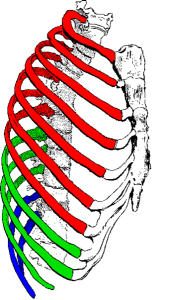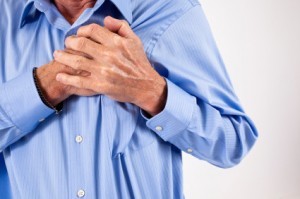Rib Pain – Causes and Other Symptoms
Why do the ribs pain?
Pain from the ribs may occur for many of the same reasons as pain elsewhere in the body. Despite bones being hard and tough, it can also be injured in various ways even if it is not fractured. This can result in pain. Usually the pain is felt over the affected rib and pressure may worsen it (tenderness). However, it is not always possible to identify pain emanating from the ribs.
As part of the chest wall, the ribs lies under surface structures like skin, muscles, tendons, ligaments and fascia, as well as neighboring structures like the costal cartilages and sternum (breastbone). With regards to the sternum, refer to breastbone pain. In milder cases the pain may be due to chest wall bruising and rib injury while it severe cases the rib may be fractured.
Other Symptoms
Rib pain is a symptom. It can vary in intensity from minor tenderness to excruciating pain. Tenderness is where the pain is only felt upon direct pressure on the affected part. Rib pain may also be accompanied by other symptoms such as:
- Pain when breathing
- Difficulty and pain when moving arms
- Chest, shoulder and/or back pain
- Bruising on the chest wall
There may be a host of other signs and symptoms. Some may be generalized and non-specific like a fever in a rib infection. Other signs and symptoms may be due to other conditions that does not involve the ribs but is mistaken for rib pain. For example, nausea may occur with acid reflux along with chest pain (heartburn).
Pain can be referred, where it starts elsewhere in the body but is felt at the rib. Another possibility is radiation where the pain originates at another site but extends to the ribs.
WARNING: Any chest pain that is associated with difficulty breathing or shortness of breath, coughing up of blood and/or dizziness/lightheadedness needs to be immediately assessed by a medical professional. This could be a serious and life-threatening condition like a heart attack. People who are at high risk of a heart attack or other serious conditions that may be mistaken for rib pain need to be cautious and always seek medical attention even if the pain is minor.
Causes of Rib Pain
There are 12 pairs of ribs in the human body. These ribs connect to the vertebrae at the back and the breastbone at the front, either directly or indirectly through the costal cartilages. The last two ribs on either side do not connect to the costal cartilages and are known as the floating ribs. Between the ribs lies the intercostal muscles, nerves and blood vessels.
The ribs provide a framework for the thoracic cavity and also protects the vital organs such as the lungs and heart. Severe injury to the ribs can compromise the internal organs and can even become life-threatening. However, it is important to note that there are many other organs and structures lying in close proximity to the ribs. Therefore what seems like rib pain may be pain that does not actually arise from the ribs.
Chest Wall Trauma
Trauma to the chest wall is a common type of injury often seen with contact sports, motor vehicle accidents and assaults, as well as other forms of blunt and sharp force trauma. The extent of the injury depends on the severity of the trauma. In these cases the rib is not usually injured in isolation. The surrounding muscles, tendons, ligaments, fascia, subcutaneous fat and skin is also affected.
Costochondritis
Costochondritis2 is a condition where the costal cartilages are inflamed. These cartilages connect the ribs to the sternum. There is a number of different reasons why the costal cartilages may be inflamed including strain, trauma and with conditions like fibromyalgia where the exact cause is unclear. Strain may be linked to lifting heavy weights, deep and difficult breathing as well as coughing.
Fractured Rib
The rib is a relatively thin bone and can easily be fractured with sufficient force to the chest wall. A crack may occur on the rib or it can break. In severe cases the broken end may penetrate the chest wall and protrude through it. Similarly it can pierce internal organs like the lung. Apart from external force, the ribs can also fracture with excessive and severe coughing.
Flail Chest
A flail chest is a condition that arises with rib fractures. In a flail chest there is multiple breaks in one rib or adjacent ribs thereby allowing one segment of the chest wall to move independently of the rest of the chest wall. It can a life-threatening condition and prompt medical treatment is necessary. The fracture can also involve the sternum (breastbone).
Bone Infection
Osteomyelitis is an infection of the bone. As with any bone, the rib can also become infected. Most of the time the infection is due to bacteria. These microbes are typically introduced from the external environment when the skin is pierced and then the bone is inoculated with the bacteria. However, the infection can also reach the bone internally when it spreads from another site either through direct spread, the lymphatic system or blood circulation.
Bone Cancer
Bone cancer is where a malignant tumor develops in the rib. It can originate from the rib (primary cancer) or it can arise elsewhere and then spread to the rib. This spread is known as metastasis. It may occur with direct spread where cancer from a neighboring organ spreads to the rib, or via the bloodstream or lymphatic system. The ribs, along with the spine and pelvis (hip bones), are the more commonly affected sites in bone metastasis.
Other Causes
It is important to consider the conditions that may be mistaken for rib pain. This includes:
- Shingles
- Angina pectoris – cardiac pain
- Heart attack (myocardial infarction)
- Pericarditis
- Pneumonia – lung infection
- Pleuritis
- Esophagitis
- Gastroesophageal reflux disease (GERD)
- Gastritis
- Peptic ulcers
- Pancreatitis
- Gallstones
- Bronchitis
- Lung cancer
These are only some of the possible conditions that me be mistaken for rib pain. Sometimes a pinched nerve at the back can cause pain along the path of a rib but the bone itself is not affected. Instead the pain arises from the compressed nerve.



